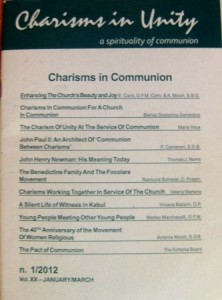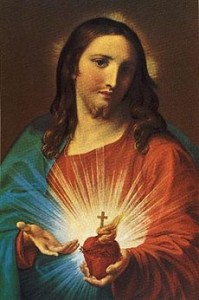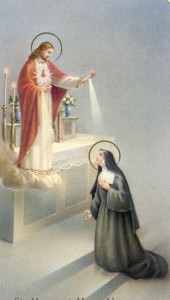The Heart of Jesus and the Focolare:
Posted by Fr. JonathanJun 14
In this week’s blog, it is my pleasure to present an article written by a good friend of mine, Angela Graham. She is a writer, a married ‘mum’ of three and is involved in TV presentations in Wales; she is also a member of the ‘Focolare’, movement. Largely leaving aside the traditionally historic Catholic view of devotions to the Sacred Heart of Jesus, and some ideas that were largely ‘wrapped up’ in a rather sentimental past, her article takes on a more critical look at the ways the Church – the whole mystical Body of the Church – now focuses attention on the Image of the Sacred Heart, and the love of Jesus, it portrays, for all mankind. Friday, 15 June 2012, is the Feast of the Sacred Heart.
Fr. Jonathan
 |
“I am a laywoman, involved with the Focolare Movement. I have been a reader of the magazine “Charisms in Unity” produced by the Religious of the Focolare Movement for some years and find it full of wonderful things. It has been inspiring to read about the lives and enterprises of religious. In the January/March edition, Vol. XX, I read the article, “The 40th. Anniversary of the Movement of Women Religious” by Antonia Moioli, S.B.G. and received an especially welcome gift. She writes about the encounter on April 14th, 1971 between women religious and Pope Paul VI, in St. Peter’s Square, a meeting which is regarded as “… the official and public inauguration of the Movement of Women Religious, Adherents of the ‘Focolare’ Movement”, to use Chiara Lubich’s (Founder of the Focolare Movement) words of the time. The Pope told them, “We know that you have come together precisely in order to be close to the “Focolare”, that is, to the Heart of the Lord which irradiates charity. You intend, in fact, to go to the Lord’s school, to the Lord’s “Focolare”, to warm and enflame your hearts with the charity of the Lord.”
 |
I was very struck by this statement that the ‘Focolare’ is “… the Heart of the Lord which irradiates charity”. As an Irish person, I grew up under the gaze of the Sacred Heart of Jesus. Almost every Irish Catholic home displayed an image of Jesus, pointing to his ‘blazing’ heart. It was a common gift to ‘newly-weds’. Most churches had two side altars, one to the Virgin Mary and the other to the Sacred Heart. Windows depicting the Sacred Heart were common, often showing St. Margaret Mary Alacoque, the seventeenth-century French nun who promoted devotion to the Sacred Heart. The practice of keeping the Nine First Fridays, linked to the Sacred Heart, was widespread; this involved reception of Holy Communion on the first Friday of nine consecutive months, in fulfilment of the condition for a ‘good death’. Most Catholics had some knowledge of the Promises of the Sacred Heart, made to St Margaret Mary. Novenas to the Sacred Heart were popular, as were insertions in newspapers, offering to the Sacred Heart, “Thanks for favours received”. In short, the image of that ‘burning heart’ was all around us.
 |
Jesus Appears to St. Margaret Mary
Yet no one ever really explained what the image was about. There was an assumption that we understood. It was used to tell us how much Jesus loved us, but this was almost overwhelmed by the emphasis placed on how we did not love him sufficiently in return. As a result, I read his gaze as one of reproach, on the whole. Many social factors of those times, in Ireland, led to the devotion often coming across as something resorted to by powerless, desperate people, with nowhere else to turn, rather than as something as first, and foremost, life-affirming.
And how did one translate all that love of his into something useful for everyday life? We were encouraged to take our troubles to him, put flowers before his image, and say, “Sacred Heart of Jesus, I put all my trust in thee,” but I did not understand how to link this devotion properly to my life. As a young adult, I found a leaflet in a church, which in a small way made a link between behaviour and the devotion, and I remember feeling indignant that nobody had explained this before. It was something to do with God loving us, and we loving others. Perhaps, I was particularly dim!
Many years later, I researched the origins of the devotion, its development and spread, and this opened up to me a better understanding of that aspect which I had found hard to grasp: “In this is love, not that we loved God but that he loved us and sent his Son to be the expiation for our sins.” (1 John, 4: 10). I had received the impression that the devotion was about our efforts to love God, but I now began to understand that, devotion to the Sacred Heart, is a school in taking hold of the fact that God loves us. That is what the imagery is trying to convey – God’s personal love for each individual, whether or not, that person responds. I sensed that there is, in this, something that is good for me, and so I make the Novena to the Sacred Heart, and, occasionally, say the Litany, because these are statements of the primacy of God’s love for me.
“No man has ever seen God; if we love one another, God abides in us and his love is perfected in us.” (1 John, 4:12). ‘Focolare’, I had always heard, is a word that means ‘hearth’, the place where the fire burns. Until reading the “Charisms in Unity” article, I had not come across a link made between this hearth and the Heart of the Lord, but now, of course, the link is clear. For me, the long-established devotion, and the new charism are seen as one in essence. If the “Lord’s Focolare” is “the Heart of the Lord which irradiates charity”, then the members of the Movement – who are at one with each other – live in that Heart.
Are there implications? I can sense two, at least. In my parish church, built in 1911, the central window high up in the nave is of the Sacred Heart, and there is a side-altar of the same dedication. Devotional practices were somewhat eclipsed in many parishes, post-Vatican II, in a well-intentioned shift of emphasis away from, potentially, lifeless outward forms of religiosity, and, at present, there may be a fear that such devotional forms are associated with a fortress-mentality, or a bias, against a Catholic faith fully engaged with the times in all their complexity. However, we now have a wonderful new window on the devotion. The Sacred Heart of Jesus is the hearth, or, to use a phrase from the Litany, “… the glowing furnace” (fornax ardens) of charity, in which the Spirituality of Communion, forges many hearts into one. I’m not wise enough to do more, at the moment, than wish to draw attention to the link between the Heart of the Lord and the ‘Focolare’. I am pleased to be able to see my own efforts to build unity, in my Volunteers nucleus, (a temporary Focolare), as steps towards living in the Heart of Jesus. Secondly, I dimly perceive the possibility of presenting devotion to the Sacred Heart of Jesus, in a fresh and contemporary way.
So thank you to “Charisms in Unity” for this wonderful gift.”
Angela Graham
To view – and read – the blog, without disruption to formatting, readers are advised to go to the main blog site.

No comments